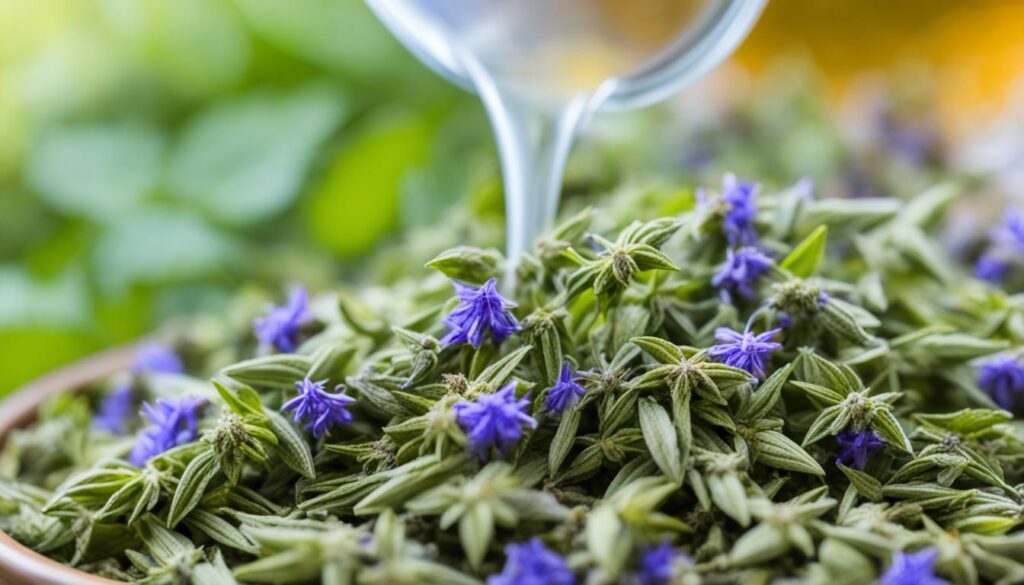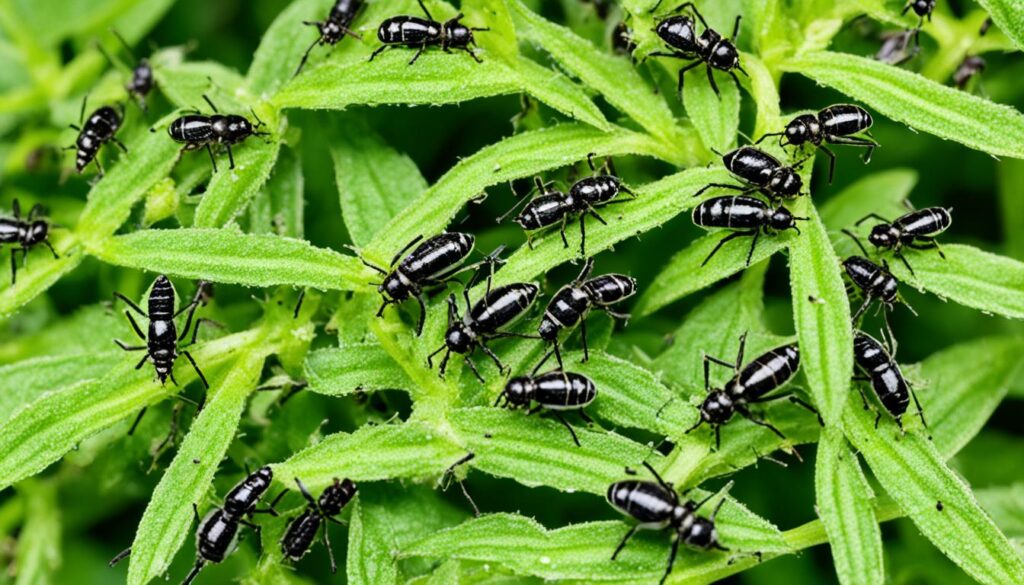Welcome to your ultimate guide on Anise Hyssop! This guide covers how to grow Anise Hyssop and its uses in the garden and kitchen. It’s a mid- to late-summer flowering perennial that makes your garden look great and helps with garden biodiversity.
Learn how to care for this amazing plant to enjoy its tasty and fragrant qualities. You’ll also learn about its benefits, like attracting pollinators and keeping pests away. Let’s dive into the world of Anise Hyssop and get all the info you need to grow it well.
Introduction to Anise Hyssop
Anise Hyssop, known as Agastache foeniculum, is a native perennial herb. It has a lovely aroma and unique taste. This Anise Hyssop plant grows 2 to 4 feet tall and thrives in zones 4-8. Its purple flowers and anise-scented leaves make it a favorite in gardens.
This herb attracts pollinators, making your garden more lively. It’s part of the mint family and lives about 2 to 3 years. Anise Hyssop spreads by self-seeding, so it keeps coming back.
Anise Hyssop grows well in many soils but doesn’t like wet feet. It needs at least six hours of sunlight a day. Once it’s settled, it can handle drought, making it easy for gardeners. You can use its leaves and flowers in tea, jelly, baked goods, and salads. This plant is beautiful and useful, perfect for garden lovers.
Benefits of Anise Hyssop in the Garden
Anise Hyssop brings many benefits to your garden. It’s not just pretty; it’s also useful. Its sweet smell draws in pollinators, making it a top choice for gardeners.
Attracting Pollinators
The bright purple flowers of Anise Hyssop draw in bees, butterflies, and other helpful insects. Adding this herb makes your garden a better place for these important creatures. It helps make your garden more diverse.
Natural Pest Repellent
Anise Hyssop benefits include keeping pests away naturally. Its scent keeps common pests away, cutting down on the need for harsh chemicals. This makes your garden healthier and safer for your plants.
Medicinal Properties
Anise Hyssop is good for your garden and your health. It’s known for its healing properties, like fighting inflammation and aiding digestion. Adding it to your garden means you have a natural remedy for many health issues.
Growing Anise Hyssop: Climate and Soil Requirements
To grow Anise Hyssop well, you need to know the climate and soil it likes. This herb can grow in many gardens because it adapts to different conditions.
Hardiness Zones
Anise Hyssop (Agastache foeniculum) does best in zones 4 to 8. It can handle the changing temperatures in these zones. This makes it a great choice for many gardens.
Preferred Soil Types
Anise Hyssop likes soil that drains well and is rich in organic matter. This stops water from building up and harming the roots. It’s also good at handling drought and high humidity.
Sunlight Needs
Anise Hyssop needs full sun to partial shade to grow well. This sunlight helps it make lots of flowers, which attract bees and butterflies. It also makes the leaves taste better.
Following these guidelines will help you grow Anise Hyssop successfully. By meeting these needs, your garden will have a thriving herb. This herb is great for cooking and helps local wildlife. For more gardening tips, check out the privacy policy.
| Requirement | Details |
|---|---|
| Hardiness Zones | 4 to 8 |
| Soil Type | Well-drained, loamy soil |
| Sunlight | Full sun to partial shade |
Planting Anise Hyssop: Step-by-Step Guide
Start by picking a spot that gets at least 6 hours of sunlight daily. Anise Hyssop loves well-drained soil. Make sure the soil is ready by loosening it and adding organic matter.
- Space your Anise Hyssop plants 18-24 inches apart to promote good airflow.
- Water the plants generously right after planting.
- Check on their growth often, looking for any signs of trouble like droopy leaves.
Don’t forget to water your plants right. Too much water can cause droopy leaves, while not enough can also be a problem. Adjust your watering based on how dry the soil is. Pruning helps keep your plants healthy and lets you make bouquets.
For more tips on plant care, check out the plant care guide. With the right care, your Anise Hyssop will bloom beautifully from summer to fall.
| Aspect | Recommendation |
|---|---|
| Sunlight | 6 hours minimum |
| Soil Type | Well-drained, organic-rich |
| Spacing | 18-24 inches apart |
| Watering | Based on soil dryness (check soil weekly) |
| Pruning Frequency | As needed, avoid removing more than 1/3 of the plant |
Watering and Care for Anise Hyssop
Proper care for Anise Hyssop is key for vibrant growth and a good harvest. Knowing how to water and fertilize Anise Hyssop helps you grow healthy plants in your garden.
Optimal Watering Practices
Anise Hyssop plants do well with moderate watering. Water deeply but not too often. This helps the roots grow deep, making the plant strong against drought.
Check the soil’s moisture during the growing season. Keep it moist but not too wet. Change how often you water based on the weather and soil.
Fertilization Tips
Anise Hyssop doesn’t need a lot of fertilizer. But, a little balanced fertilizer in spring helps it grow well. Choose organic fertilizers to protect the environment and your plants.
Remove dead flowers often to keep your plants looking good and blooming longer.
| Care Aspect | Details |
|---|---|
| Watering Frequency | Deeply water 1-2 times a week, depending on rainfall |
| Fertilizer Type | Balanced organic fertilizer in spring |
| Deadheading | Remove spent flowers regularly to promote blooming |
| Pruning | Trim one-third of the plant’s height in early spring |
Harvesting Anise Hyssop for Culinary Uses

Harvesting Anise Hyssop lets you add bright flavors to your kitchen. Pick it when the flowers bloom, usually in mid-summer. Cut the stems with scissors just above a leaf node. This encourages new growth and lets you enjoy the herb’s scent.
When to Harvest
The best time to pick Anise Hyssop is during its flowering. Mid-summer is ideal for getting fresh leaves and flowers. Make sure to harvest on sunny days after the dew has dried. This boosts the herb’s flavor.
How to Store Fresh Leaves
Storing Anise Hyssop right keeps its taste and smell. Start by washing the leaves under cool water, then dry them softly. Put the leaves in a sealed container and keep it in the fridge. This keeps the herb fresh for many recipes.
For more ideas on mixing herbs in cooking, check out this guide. It’s great for your cooking adventures.
Anise Hyssop Recipes: Delicious Culinary Uses
Anise hyssop (Agastache foeniculum) is great for cooking. Its leaves add flavor and health benefits to your meals. Use fresh leaves in salads for a refreshing taste.
Or, infuse them in syrups to sweeten drinks and desserts. This adds a unique twist to your creations.
The flowers of anise hyssop are also useful. They can be used as a garnish for cocktails or desserts. This adds beauty and a subtle flavor to your dishes.
Herbs like anise hyssop are perfect for summer drinks. Consider making a cold brew tulsi tea with tulsi leaves, dried schisandra berries, and fresh mallow leaves. This tea is soothing and good for your health.
For a step-by-step guide on making this tea, check out this helpful guide.
Adding anise hyssop to your recipes makes food tasty and helps with digestion and the immune system. Simple ingredients can lead to amazing dishes. The world of culinary uses of Anise Hyssop encourages creativity in the kitchen.
Making Anise Hyssop Tea

Making Anise Hyssop tea is a great way to enjoy its health perks. This tea has a special taste that many love. It’s easy to make and can help you feel better.
Health Benefits of Anise Hyssop Tea
Anise Hyssop tea is known for its health benefits. These include:
- Aiding digestion
- Providing anti-inflammatory properties
- Supporting respiratory health
- Reducing anxiety and promoting relaxation
Drinking Anise Hyssop tea often can make you feel better. It offers many natural healing benefits.
How to Brew Anise Hyssop Tea
To make this tasty tea, just follow these steps:
- Gather your ingredients: Use 1-2 teaspoons of fresh or dried Anise Hyssop leaves.
- Boil a cup of water.
- Add the Anise Hyssop leaves to your boiling water.
- Let it steep for about 10 minutes.
- Strain the leaves and pour your tea into a cup.
You can add honey or lemon to your tea for more flavor. This tea is not only delicious but also good for you. It’s a great choice for your daily routine.
Understanding the Anise Hyssop Plant in Your Landscape
Anise Hyssop (Agastache foeniculum) is a great choice for your garden. It grows 2 to 4 feet tall, perfect for borders and mixed beds. The tall stems with purple flowers add beauty and attract pollinators and garden lovers.
Creating a beautiful garden is easy with Anise Hyssop. It grows in zones 4-10 and loves well-drained soil and lots of sun. This tough plant can handle drought and grows well in different soils. Its scent makes your garden more enjoyable.
Anise Hyssop can soften rough garden edges with its vibrant color. It has beautiful flowers that attract butterflies and other good insects.
Pair Anise Hyssop with other native plants for a diverse garden. Here are some good matches:
| Plant Name | Height | Hardiness Zones | Sunlight Preference |
|---|---|---|---|
| Showy Milkweed | 2-5 feet | 3-9 | Full Sun |
| Blue Wild Indigo | 1.5-2 feet | 3-8 | Full Sun |
| Butterfly Milkweed | 1-3 feet | 3-9 | Full Sun |
| Sweet Joe-Pye Weed | 1-1.5 feet | 3-9 | Part Sun to Light Shade |
Adding Anise Hyssop to your Anise Hyssop landscape design makes your garden look better and helps nature. This plant makes your garden feel welcoming and supports many creatures. Enjoy its beauty and benefits as you care for your garden.
Common Pests and Diseases Affecting Anise Hyssop

Anise Hyssop is usually tough but can face pests and diseases. Spotting these pests early helps keep your plants strong. Always watch your plants closely for any signs of trouble.
Identifying Common Pests
Here are the main pests that bother Anise Hyssop:
- Aphids: These tiny bugs stick to new leaves, causing them to curl and leaving behind sticky stuff.
- Spider Mites: These tiny spiders make leaves look stippled and create webs, showing they’re there.
These pests can weaken your Anise Hyssop. It’s important to deal with them quickly.
Preventive Measures
Here’s how to keep pests and diseases away from Anise Hyssop:
- Keep your plants healthy with the right amount of water and sunlight.
- Add ladybugs to your garden to eat aphids.
- Use insecticidal soap for aphids and spider mites when needed.
- Make sure your soil drains well to avoid root rot and fungal diseases.
By being careful and taking these steps, you can have beautiful and healthy Anise Hyssop plants. This way, you’ll also keep pests and diseases at bay.
| Pest/Disease | Signs | Treatment |
|---|---|---|
| Aphids | Curling leaves, sticky residue | Insecticidal soap, ladybugs |
| Spider Mites | Stippled leaves, webbing | Insecticidal soap, increase humidity |
| Root Rot | Wilting, yellowing | Improve soil drainage |
| Powdery Mildew | White powdery spots | Remove affected leaves, improve airflow |
Companion Plants for Anise Hyssop
Choosing the right plants to grow with Anise Hyssop can make it grow better and look nicer in your garden. Good choices include echinacea, bee balm, and black-eyed Susans. These plants grow well together and draw in pollinators, making your garden a lively place for all.
Think about adding herbs like chamomile or lemon balm when planting with Anise Hyssop. Chamomile is calming, and lemon balm helps reduce stress. These herbs match well with Anise Hyssop and help create a garden that’s full of life and balance. Adding lavender and thyme will also bring in helpful insects and offer smells and tastes you can enjoy.
Planting different types of plants together makes a better home for all your plants. With the right plants around Anise Hyssop, your garden will be full of life and beauty all season long.



